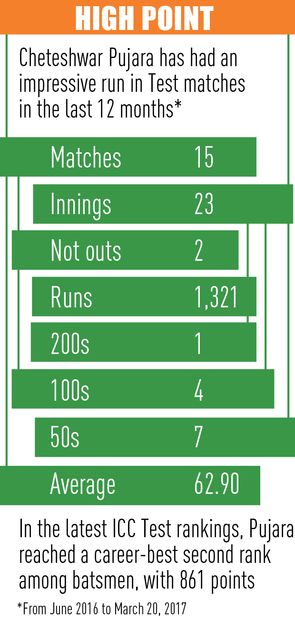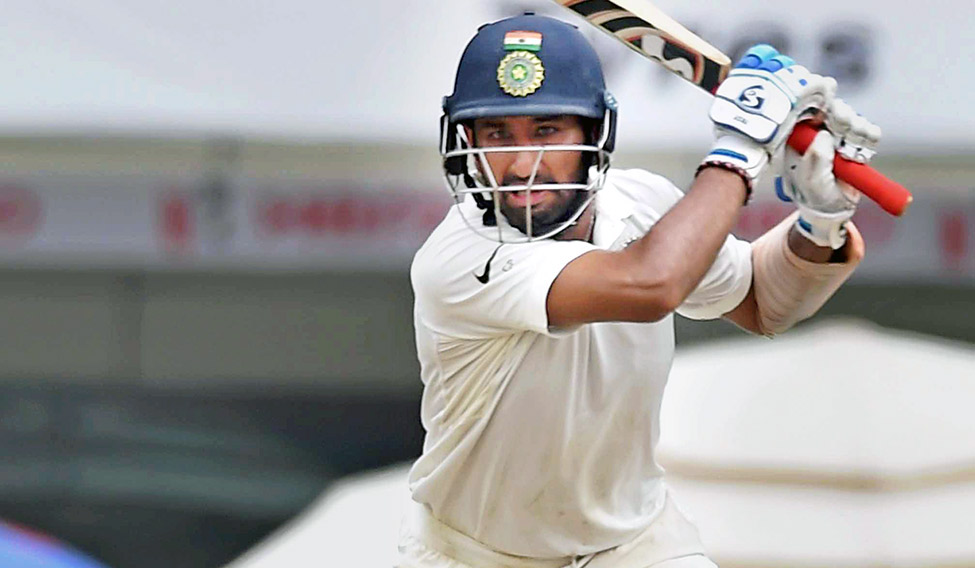I am not done yet,” Cheteshwar Pujara told a member of the support staff at the end of the third day of the Ranchi Test on March 19. He was not out at 130 and was crafting a crucial partnership with Wriddhiman Saha, one of his best mates on and off the field. The determination in the statement was difficult to ignore. On day four, at 2.50pm, his innings of 11 hours and five minutes, which yielded 202 runs, came to an end, and Pujara walked back a satisfied man.
The double hundred was doubly important. It not only helped India, yet again, to overhaul a huge deficit (450 runs) and seize initiative, but also reinforced the significance of Pujara, India’s best defence.
For him, it was a reaffirmation of his role as the batting fulcrum of the team. He played 525 balls, the most by an Indian in a Test innings, breaking Rahul Dravid’s record of 495 balls (for 270 runs) against Pakistan in 2004. Pujara is also just the sixth batsman in history to score multiple double-centuries against Australia.
“You know sometimes I really feel bad for him; people don’t understand his importance in this team and what a valuable player he is for us,” said Indian captain Virat Kohli. “He is the most composed player we have in the team. He doesn’t mind batting under pressure and he likes to take the challenge of batting. People need to stand up and take notice of what he has done this season.”

Pujara has scored 2,007 runs this first-class season, thus becoming the fourth Indian batsman to cross the 2,000 mark in a single season. “Probably this is one of my best double hundreds,” he told bcci.tv after the match. “It was a tough innings as I wasn’t having a good time initially. The first session on day three was a bit difficult but I had a good partnership with Murali Vijay and he was playing flawless cricket. Once he got out, I had to take responsibility. [But] I was set and things became easier.”
Responsibility comes naturally to the 29-year-old Saurashtra boy. For instance, during the vital 199-run partnership, he gave Saha confidence and encouraged him to play his natural game. “Puji shows a lot of patience in domestic cricket,” said Saha. “He regularly makes double and triple hundreds in domestic cricket. His patience has always been on top.” Saha and Pujara have been friends since their days in domestic cricket and spend a lot of time together. Nowadays, they occasionally enjoy a fiercely competitive match of FIFA on their gaming consoles. Also, in January, the two had a 316-run partnership in the Irani trophy.
After Pujara’s marathon innings, praise poured in from all quarters. But, what does it take to craft such a long innings? Former Indian opener Anshuman Gaekwad, who manned the crease for 671 minutes against Pakistan in 1983, offered his insight. “It is about getting the maturity and experience to be able to play such an innings (Pujara lasted a minute longer than Gaekwad). He was able to balance things out,” said Gaekwad. “You need to have a lot of determination, patience and concentration. It was a responsible knock. It wasn’t flamboyant nor subdued. It was the right kind of approach to batting.”
Apparently, the Aussies thought so, too. “He’s very disciplined and played really well. That’s why he is a class player,” said Australia’s coach Darren Lehmann. “He bats for a long period of time. His conversion rate is pretty high. When he gets in, he likes to go on with it. That’s a challenge for our bowling group.”
The Pujara of today has been moulded from all the setbacks and criticism over the past seven years—he made his Test debut in 2010. Said Sitanshu Kotak, Pujara’s former Saurashtra skipper and coach: “He takes criticism positively. You see the high scores this domestic season. It is because he made efforts to improve. If he makes a mistake, he learns from it and never repeats it.”
Kotak cites the example of the West Indies tour in 2016. This was Kohli’s first full tour as captain and Anil Kumble’s first as head coach. They dropped a bombshell when they picked Rohit Sharma ahead of Pujara in the third Test in Saint Lucia. The reason given was Pujara’s slow strike rate—he had gone into a meditative shell in the previous Test. “The team management wanted results and quick runs,” said Kotak. “He was dropped, but he went back to domestic cricket and focused on how to make his strike rate better.”
One of the highlights of Pujara’s batting, said Kotak, was his ability to punish loose balls. “On wickets like the ones at home, he converts about 90 per cent loose balls into runs,” he said. “Most batsmen will have a 50 to 60 per cent conversion rate. They score with more attacking shots, which come with risk. Pujara won’t give the bowlers that chance.”
In a team full of expressive players, both on and off the field, Pujara is the shy one. However, opponents should not mistake his reserved nature for meekness. For instance, when Aussie pacer Josh Hazlewood tried to unsettle Pujara with a verbal volley, he replied by saying, “Just look at the scoreboard.” In the Bengaluru Test, while fielding at forward short leg, he kept reminding Australian opener David Warner that he was Ravichandran Ashwin’s bunny (Ashwin has dismissed Warner more times than any other bowler in Tests). “He’s aggressive as a cricketer but doesn’t show it,” said Kotak.
The next step for Pujara is to pass the perennial litmus test for an Indian batsman—overseas success. Though he has played 18 away Tests with a century each in South Africa and Sri Lanka, he has not scored big in the West Indies, England and Australia. “He will have to address that,” said Gaekwad. “He has to work a bit on his footwork and on the short ball. But, more than that, it is a question of adaptability.”
That is part of the bigger plan. Last season, after two poor overseas series, Pujara went for a short county stint with Yorkshire to adapt to foreign conditions and green wickets. “If the team wins, it is fine, but if the chips are down, people start looking at individuals and pick out weaknesses and records,” said Kotak. “It is important to have the experience of playing in such conditions.” With no takers for Pujara in the shorter formats, he will soon head to England again.







